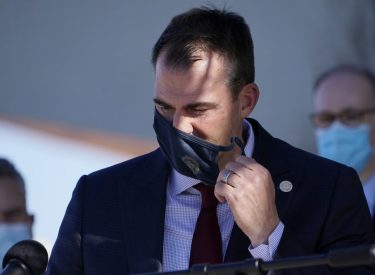Tulsa’s ICUs at capacity as Coronavirus Surges
Mike Seals - November 10, 2020 10:19 pm

By KEN MILLER
OKLAHOMA CITY (AP) — Tulsa’s hospitals reached capacity for intensive care patients for a time Tuesday, then eased, according to the head of a Tulsa hospital system, while state officials reported a one-day record high in hospitalizations statewide amid coronavirus surges in Oklahoma.
“Bed capacity is extremely fluid and it can change hour to hour,” as patients could be transferred to other hospitals in the state, or even to a nearby state, said Ascension St. John Medical Center CEO Jeff Nowlin.
Gov. Kevin Stitt said steps are being taken to ensure patients have access to hospital care with the activation of the state’s Regional Medical Response System, which is used to transfer patients to available hospitals during disasters such as tornadoes. Stitt said hospital officials also asked for more nurses to help care for the patients.
“We’ve instructed the nursing board to clear any red tape to allow nursing students and nurses who are licensed in other states to practice in the state of Oklahoma,” Stitt said.
Stitt and hospital officials in Oklahoma City joined in a news conference to, as Stitt said, plead with residents to voluntarily socially distance, wash hands and wear masks, but he again said he would not issue a statewide mask mandate.
“I’ve been very clear that I don’t think that’s the right thing to do. This is a personal responsibility, this pleading with people to do the right thing,” and voluntarily wear a mask, Stitt said.
“I don’t believe in a one size fits all approach,” Stitt said, noting some counties in western Oklahoma have fewer than 100 reported cases of the virus.
Stitt said he supports individual cities, which include Oklahoma City, Tulsa and Norman, that have passed mask mandates.
Tulsa Mayor G.T. Bynum said a mask mandate was needed in the city because many people would not voluntarily wear one.
“We’re still debating if people should wear masks or not in our region, ridiculous,” Bynum said. “I still can’t find a good policy-based explanation for why we would not (mandate masks). … Everything that we have an ordinance for you should be doing on your own anyway, but ultimately it has to be put into law.”
Bynum said Tulsa, as a regional medical hub, needs other cities in the area to take steps to slow the spread of the virus because Tulsa is the only one with a mask ordinance, though officials in the suburb of Jenks are to vote on a mask mandate.
Data from Johns Hopkins University shows the seven-day rolling average of new cases in Oklahoma has risen from 1,332 new cases per day on Oct. 26 to 1,894 on Monday.
However, December might be optimistic. Pfizer announced Monday that its vaccine may be a 90% effective, based on early and incomplete test results. The Food and Drug Administration must still authorize its use, and the Centers for Disease Control and Prevention is in charge of deciding who is first in line for the extremely limited supplies that will first come out.
The Oklahoma State Department of Health reported 1,102 hospitalizations statewide Tuesday to surpass the previous one-day record high of 1,055 recorded Thursday.
There were 1,702 new cases reported in Oklahoma to bring the total number since the pandemic began to 140,157 and 1,451 deaths, an increase of seven from Monday, the health department reported.
The true number of infections is likely higher because many people haven’t been tested, and studies suggest people can be infected and not feel sick.
The Democratic leader in the state House, Rep. Emily Virgin, criticized Stitt for what she called a failure to take steps to control the virus’ spread, such as issuing a statewide mask mandate.
“There have been more than 1,400 COVID deaths in Oklahoma, and the governor has not come up with a single plan to keep that number from getting to 2,000. This is a total failure in leadership,” Virgin said.
For most people, the coronavirus causes mild or moderate symptoms, such as fever and a cough that clear up in two to three weeks. For some, especially older adults and people with existing health problems, it can cause more severe illness, including pneumonia, and death.



